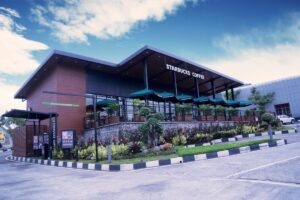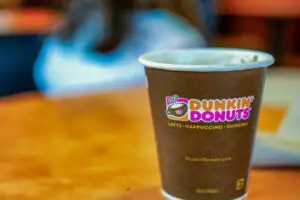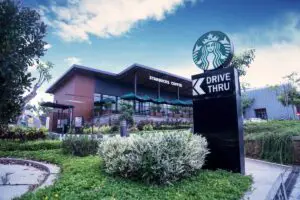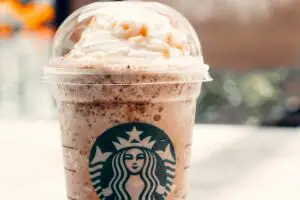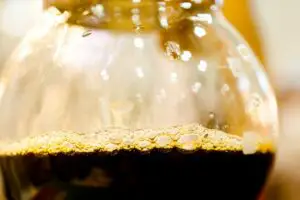*This post may contain affiliate links. As an Amazon Associate we earn from qualifying purchases.
Alright, folks, gather around. Have you ever had a sip of Starbucks coffee, scalded your tongue and wondered, “Just how hot is this liquid lava?” Well, you’re in luck because that’s the rabbit hole we’re about to tumble down.
As a mom of three young, energetic caffeine enthusiasts-in-training, I’ve spent more time at Starbucks than I’d like to admit. I mean, I’ve got baristas who know more about my sleep schedule than my husband.
Heck, my five-year-old knows how to spell ‘cappuccino’ before ‘cat’ (okay maybe not quite but you get my point). This isn’t just a walk in the park, it’s a deep dive into the sizzling world of Starbucks’ coffee temperature.
Buckle up, my friends, it’s going to be a steamy ride.
Absolutely, let’s distill the wisdom from our coffee talk into some key takeaways:
Key Takeaways
- Coffee Temperature and Flavor: The temperature of coffee significantly impacts its flavor. The optimal range for brewing coffee is between 195°F and 205°F. Any cooler, the coffee is under-extracted and weak. Any hotter, it becomes over-extracted and bitter.
- Coffee Temperature and Experience: The temperature of coffee also affects the overall drinking experience. Too hot, and you risk a burnt tongue; too cold, and it’s not very enjoyable.
- Starbucks’ Temperature Management: Starbucks uses high-quality brewing equipment designed to heat water to the optimal temperature for coffee. The company also trains its employees rigorously on maintaining optimal coffee temperatures.
- Starbucks Coffee Temperature: The standard serving temperature for hot drinks at Starbucks is between 150°F and 170°F. However, there can be variations across different beverages.
- Customizing Coffee Temperature at Starbucks: Starbucks allows customers to customize the temperature of their drinks. You can ask for your drink to be a bit cooler or hotter than the standard temperature. Starbucks also offers a ‘Kid’s Temperature’ option that serves the drink at a safer 130°F.
- Temperature Lawsuits and Starbucks: Starbucks has faced several lawsuits over coffee temperature. In response, the company has improved staff training, added clearer warning labels, and redesigned cups for safer handling.
In the end, the journey into the temperature of Starbucks coffee reveals a world of precision, customization, and continuous improvement. The next time you enjoy a cup, remember the art and science that goes into ensuring your coffee is just right.
History of Starbucks and Coffee Temperature
A Brief History of Starbucks
Starbucks, ah, the siren call for every sleep-deprived parent, overworked employee, and college student pulling an all-nighter. Founded in 1971, Starbucks has transformed from a single, humble store in Seattle to a caffeinated titan with more than 30,000 locations worldwide.
And trust me, when you have a screaming toddler in the backseat, those green mermaid signs are a beacon of hope. I’ve personally prayed to the coffee gods for a nearby Starbucks during some road trips.
But Starbucks isn’t just a coffeehouse, it’s a cultural phenomenon. You don’t just drink Starbucks, you experience it.
You know you’ve reached a new level of adulthood when you transition from Frappuccinos to black coffee. But this isn’t a history lesson, no siree! We’re here to talk about how their coffee goes from pleasantly warm to tongue-searing hot.
Evolution of Starbucks’ Coffee Temperature Policies
The truth is, Starbucks hasn’t always been consistent with their coffee temperatures. Back in the ’70s, you could order a coffee and not worry about it being as hot as the sun (yes, Starbucks was founded in the 1970s!).
Then again, the bell-bottoms were pretty distracting.
But over time, the company began to up the temperature. Why, you ask? Well, legend has it that the higher temperatures helped to bring out the flavor of the beans.
Or maybe they just wanted to ensure the coffee was still hot by the time it reached the 12th car in the drive-through queue. Either way, the temperatures rose, and the tongues felt the heat.
Now, here’s a handy-dandy table showing the approximate evolution of the serving temperature over the years:
| Year | Approximate Serving Temperature |
|---|---|
| 1970s | 150°F |
| 1980s | 160°F |
| 1990s | 170°F |
| 2000s and onwards | 180-190°F |
Notable Incidents Related to Starbucks’ Coffee Temperature
And as the temperatures rose, so did the incidents. There have been a few ‘hot coffee’ lawsuits that have made it into the headlines.
One, in particular, was Liebeck v. McDonald’s Restaurants, where a lady suffered third-degree burns from the coffee. Starbucks has also had its share of lawsuits, though not as many as you’d think, considering they serve over 8 million cups of coffee a day.
One day, I was at my local Starbucks, kids in tow. My eight-year-old son, always the scientist, asked the barista, “Why is the coffee so hot?” The barista, bless him, gave my son a detailed explanation about optimal temperatures and flavor extraction.
My son walked away with a new word in his vocabulary – thermodynamics.
But don’t let these stories scare you. These cases are rare, and Starbucks has safety policies in place, which we’ll explore later. For now, remember this: the history of Starbucks is as rich and complex as the Dark Roast I order to survive my 12-year-old’s soccer practices.
Why Coffee Temperature Matters
The Role of Temperature in Coffee Flavor Extraction
If you think coffee is just water and beans, my friends, you’re sorely mistaken. It’s a delicate dance, a symphony of flavors, and temperature plays the violin.
Too cold, and your coffee tastes like muddy water. Too hot, and it’s as bitter as my face on a Monday morning pre-coffee.
Here’s the thing, the temperature affects the rate at which the flavors are extracted from the coffee beans. It’s all science, but don’t worry, there won’t be a quiz at the end.
For your reference, here’s a table that explains how different brewing temperatures affect the coffee flavor:
| Temperature Range | Effect on Coffee Flavor |
|---|---|
| Below 195°F | Under-extracted, weak flavor |
| 195°F – 205°F | Optimal extraction, balanced flavor |
| Above 205°F | Over-extracted, bitter flavor |
Impact of Temperature on the Coffee Drinking Experience
Now let’s get personal. I remember this one time when I was at Starbucks, juggling my purse, phone, and a list of complicated drink orders from my coworkers.
The barista handed me my coffee, piping hot and smelling like heaven. I took a sip right away, forgetting how hot it could be, and what do you know? I burned my tongue!
I couldn’t taste anything properly for the rest of the day, and let me tell you, lasagna without the taste is just squishy layers of sadness.
The temperature of the coffee directly impacts our drinking experience. Too hot, and you risk a scorched tongue, too cold, and it’s about as enjoyable as lukewarm bathwater.
Health Implications of Hot Coffee
Ever tried to explain to a five-year-old why she can’t have a hot drink? It’s like negotiating with a gremlin. But the fact is, hot beverages can pose health risks, and it’s not just about the burn hazard.
According to the World Health Organization, drinking beverages hotter than 149°F can lead to esophageal cancer. Scary stuff, right? But don’t worry, your favorite Starbucks latte isn’t out to get you.
Starbucks, like most coffee shops, serves coffee at a temperature well below that.
In the grand scheme of things, temperature matters, folks! It’s not just about avoiding a burnt tongue or keeping the WHO happy. It’s about the harmony of flavors, the joy of that first sip, and the comfort of a warm cup in your hands.
As for me, my coffee temperature is directly proportional to the chaos in my household. The louder the kids, the hotter the coffee.
How Starbucks Measures Coffee Temperature
Starbucks’ Standard Procedures for Heating Coffee
Brewing coffee at Starbucks isn’t just a matter of pushing a button. It’s a process that’s been refined and standardized over the years, much like my routine of breaking up sibling squabbles over who gets the last cookie.
Starbucks follows a specific procedure to ensure their coffee is always at the right temperature. They use high-quality brewing equipment, automated to heat the water between 195°F and 205°F – the sweet spot for optimal flavor extraction.
Trust me, they’re more consistent with their temperatures than my 12-year-old is with her moods.
Tools and Equipment Starbucks Uses to Maintain Consistent Coffee Temperatures
Ever wondered what magical tools Starbucks uses to maintain their coffee temperatures? They’re not hiding a dragon in the back room (I checked).
The magic is all in their top-notch coffee machines and thermal carafes. These machines are like the Ferraris of the coffee world, designed to heat the water to the perfect temperature and maintain it consistently.
| Tool | Purpose |
|---|---|
| High-Quality Coffee Machines | Heat water to the optimal temperature |
| Thermal Carafes | Maintain the coffee temperature post-brewing |
Employee Training on Maintaining Optimal Coffee Temperature
And let’s not forget about the baristas, the unsung heroes of our caffeine-infused lives. These folks undergo rigorous training on everything from coffee origins to brewing techniques, including maintaining the optimal coffee temperature.
Next time you see your barista, give them a nod of appreciation. They’re doing the Lord’s work.
Once, I asked a barista how they manage to keep the coffee so consistently hot. With a twinkle in his eye, he said, “Ma’am, we’re not just serving coffee, we’re serving comfort in a cup. And comfort has to be warm.”
I tell you, folks, that’s some philosophical stuff right there.
Remember, behind every steaming cup of Starbucks coffee is a team of dedicated coffee lovers who ensure that every sip you take is just right. Just like how I ensure my kids’ clothes match before they leave for school. It’s an art and a science.
The Exact Temperature of Starbucks Coffee
Average Serving Temperature of Starbucks Coffee
The million-dollar question, folks, is “how hot is the coffee at Starbucks, really?” After all, who hasn’t been curious about the scorch factor of their favorite brew?
Well, according to Starbucks, the standard serving temperature for their hot drinks is between 150°F and 170°F. But remember, folks, “standard” is a tricky word. It’s like when my kids say they’ve standardly cleaned their rooms, and I find a family of dolls and dust bunnies under the bed.
Variations in Temperature across Different Starbucks Beverages
Not all Starbucks drinks are created equal, especially when it comes to temperature. For instance, the temperature of an iced caramel macchiato is very different from a hot caramel macchiato.
I learned this the hard way when I accidentally ordered the iced version on a chilly winter morning. Let’s just say my teeth are still chattering.
Here’s a handy table that breaks down the typical temperatures for different Starbucks drinks:
| Drink | Typical Temperature |
|---|---|
| Hot Coffee | 150°F – 170°F |
| Hot Latte | 150°F – 170°F |
| Hot Tea | 200°F |
| Iced Coffee | Around 45°F |
| Cold Brew | Around 45°F |
Comparing Starbucks’ Coffee Temperature with Other Major Coffee Chains
Now, how does Starbucks’ coffee temperature stack up against the competition? From my experience, it’s like comparing my cooking to my mother-in-law’s – everyone has an opinion.
Generally, most major coffee chains, including Dunkin Donuts and McDonald’s, serve their coffee at similar temperatures to Starbucks. After all, nobody likes lukewarm coffee.
Remember, the next time you take a sip of your Starbucks coffee, you’re not just tasting a blend of beans and water. You’re experiencing a carefully calibrated temperature designed to bring out the best in every sip.
It’s a science, an art, and a lifesaver for tired moms everywhere.
Customizing the Temperature of Your Starbucks Coffee
Asking for a Specific Temperature at Starbucks
This is where things get interesting. Did you know you can customize your Starbucks coffee temperature?
Yes, folks, the power is in your hands!
So, if you want your drink a little cooler or hotter than the standard 150°F to 170°F, all you have to do is ask. The baristas will adjust the temperature to your liking, within reason of course.
No, they won’t serve you coffee as cold as your ex’s heart.
Starbucks’ ‘Kid’s Temperature’ Option
Did you know Starbucks has a ‘Kid’s Temperature’ option? This option serves the drink at a cooler 130°F, safe for the little ones. I discovered this when my 12-year-old developed a taste for chai lattes.
It’s a great option if you’re sharing with the kiddos, or if you’re just a big kid at heart.
Iced and Cold Brew Coffee Temperatures
If hot coffee isn’t your thing, Starbucks has a range of iced and cold brew options too. These drinks are usually served at around 45°F. It’s like a refreshing splash of summer in your mouth, perfect for those sweltering days when the kids have turned the backyard into a splash zone.
Here’s a snapshot of how you can customize your Starbucks coffee temperature:
| Customization | Temperature |
|---|---|
| Standard Hot Coffee | 150°F – 170°F |
| Kid’s Temperature | 130°F |
| Iced Coffee | Around 45°F |
Remember, folks, Starbucks is all about the personalized experience. So, feel free to specify your temperature preference, just like how I specify who gets the front seat on car rides. It’s all about making the ride more enjoyable!
Starbucks Coffee Temperature Lawsuits and Controversies
High-Profile Starbucks Temperature Lawsuits
It’s a fact of life: where there’s hot coffee, there’s bound to be a few burns. Starbucks, like any major coffee chain, has had its share of lawsuits over coffee temperature.
My personal favorite is the case where a lady claimed her coffee was so hot, it melted her cup. I thought that only happened when my kids tried to microwave plastic.
On a more serious note, there have been a few high-profile lawsuits where customers suffered severe burns from spilled coffee. These cases led to calls for lower serving temperatures and better cup designs.
Starbucks’ Response to Coffee Temperature Controversies
Throughout these controversies, Starbucks has stood by their serving temperatures, stating they are within industry standards. They also stress their commitment to customer safety and satisfaction.
It’s a balancing act, like me trying to juggle grocery bags, a toddler, and my sanity.
But in response to these incidents, Starbucks has taken steps to prevent future accidents. This includes better staff training, clearer warning labels, and improved cup designs.
The Impact of Lawsuits on Starbucks’ Coffee Temperature Policies
Lawsuits and controversies have inevitably influenced Starbucks’ coffee temperature policies. They’ve been a catalyst for change, forcing the company to reassess their practices and make necessary improvements.
While these incidents are regrettable, they’ve ultimately contributed to a safer, more customer-focused Starbucks experience. Just remember, folks, hot coffee is like a hot gossip – handle it with care!
In Conclusion
So, there you have it, folks. The answer to the burning question, “How hot is the coffee at Starbucks?” is as complex and layered as the coffee itself. It involves a blend of science, standards, and a dash of personal preference.
The next time you order your favorite brew, take a moment to appreciate the careful calibration that goes into every cup. Because, just like parenting, brewing the perfect cup of coffee is a labor of love, patience, and a healthy respect for temperatures.
So, here’s to hot coffee, cooler heads, and the joy of finding the perfect brew. After all, life’s too short for lukewarm coffee and tepid enthusiasm. Stay caffeinated, my friends!

